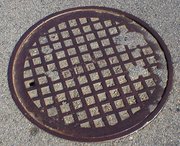Manhole cover
|
|

Princeton-manhole-cover.jpg
Manholetrondheim.jpg
A manhole cover is a removable plate forming the lid over the opening of a manhole, to prevent someone from falling in and to keep unauthorized persons out.
| Contents |
General
Manhole covers usually weigh more than one hundred pounds (50 kg), partly because the weight keeps them in place when traffic passes over them, and partly because they are often made out of cast iron, sometimes with infills of concrete. This makes them inexpensive and strong, but heavy. They usually feature pick holes in which a hook handle is inserted to lift them up.
India has become the world leader in manufacturing manhole covers, driving many manufacturers in other countries out of business. Its extremely low labor costs have overcome even the cost of shipping such heavy objects.
Why are they round?
The question of why manhole covers are typically round, at least in the US, was made notorious by Microsoft, who began asking it as an interview question. Originally meant as a psychological assessment of how one approaches a question with more than one "right" answer, the problem seems to have exerted a strange fascination on people to find alternate explanations, from the pragmatic and satirical to the philosophical.
In reality, manhole covers are round because manholes are round. Round tubes are the strongest and most material-efficient shape against the compression of the earth around them. A circle is the simplest shape whereby the lid cannot fall into the hole. (A Reuleaux triangle or other curve of constant width would also serve this purpose, but round covers are much easier to manufacture.) Circular covers can be moved around by rolling. And they need not be aligned to put them back.
However, other manhole shapes can be found; usually squares or rectangles. Nashua, New Hampshire appears to be unique in the U.S. for having triangular manhole covers that point in the direction of the underlying liquid flow. The city is phasing out the triangles, which were made by a local foundry, because they are not large enough to meet modern safety standards and larger triangles cannot be found.
Political correctness
It has been suggested that the gender-specific term "manhole cover" is not politically correct, but the gender-neutral version "person-hole cover" does not seem to have caught on. Alternative suggestions include "inspection cover" and "access hatch". One proposed name is "Maintenance Hole" or "Maintenance Hatch", which doesn't require changing the acronym and hence many city maps.
The true first man-made object in space?
According to urban legend, a manhole cover was accidentally launched from its shaft during an underground nuclear test in the 1950s, at great enough speed to leave the solar system. The myth is based on a real incident in August 27 1957 during the Operation Plumbbob nuclear tests, where a heavy steel plate cap was blasted off the test shaft at tremendous velocity, never to be seen again, although it is doubtful that it left the atmosphere.
See also
References
Printed references:
- Melnick, Mimi (1994). Manhole Covers, MIT Press, USA. ISBN 0-26213-302-4
- Stuart, Diana (2003). Designs Underfoot: The Art of Manhole Covers in New York City, The Lyons Press, USA. ISBN 1-58574-639-8
External links
- Covers to Discover (http://www.covers-to-discover.com/gb/)
- ManHole.ca - Fine Sewer Art (http://www.manhole.ca/)
- Private collection of photos of manhole covers around the world (http://www.danheller.com/manholes.html)
- Drainspotting (http://www.drainspotting.com/)
- Round Manhole Covers, or: If Richard Feynman applied for a job at Microsoft (http://www.hebig.org/blogs/archives/main/000962.php)
- Manhole Covers in Space (http://www.strangehorizons.com/2002/20021021/manhole.shtml) - exhaustive article by Debbie Moorhouse
- The Pascal-B nuclear test (http://nuclearweaponarchive.org/Usa/Tests/Plumbob.html#PascalB)
